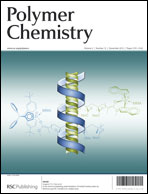This paper demonstrates the synthesis of a copolyfluorene (PFBI), containing pendant benzimidazolyl groups, from a poly[(9,9-dihexylfluorene)-alt-(9,9-dibromopentylfluorene)] (PFBr) and its chemosensory and electroluminescent characteristics. The PFBI is readily soluble in common organic solvents, such as chloroform and tetrahydrofuran, and it exhibits good thermal stability (Td > 400 °C) and high glass transition temperature (Tg > 100 °C). Absorption and photoluminescence (PL) spectra of PFBr and PFBI show main peaks at 389 nm and 420 nm, respectively. The solution fluorescence of PFBI is selectively and dramatically quenched by Cu2+ ions with very high sensitivity (Stern–Volmer coefficient Ksv = 2.6 × 106 M−1), however, it is partially quenched in the presence of Zn2+ or Cd2+ ions accompanied by a 16 nm red-shift. Protonic acids also quench the fluorescence accompanied with a red-shift. Blending the functional copolyfluorene PFBI with MEH-PPV results in significant enhancement of device performance (9820 cd m−2 and 0.65 cd A−1) [ITO/PEDOT:PSS/MEH-PPV + PFBI/Ca (50 nm)/Al (100 nm)]. The results show that polyfluorene with pendant benzimidazolyl groups is a potential candidate for selective detection of Cu2+ and as additives to enhance the performance of MEH-PPV.

You have access to this article
 Please wait while we load your content...
Something went wrong. Try again?
Please wait while we load your content...
Something went wrong. Try again?


 Please wait while we load your content...
Please wait while we load your content...